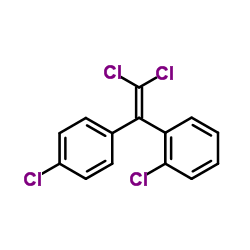DDT- and DDE-induced disruption of ovarian steroidogenesis in prepubertal porcine ovarian follicles: a possible interaction with the main steroidogenic enzymes and estrogen receptor beta.
A K Wójtowicz, M Kajta, E Ł Gregoraszczuk
Index: J. Physiol. Pharmacol. 58(4) , 873-85, (2007)
Full Text: HTML
Abstract
We evaluated impact of DDT isomers, o, p'- DDT [1, 1-dichloro-2, 2-bis (p, p'-chlorophenyl) ethylene] and p, p'-DDT [1, 1, 1-trichloro-2, 2-bis (p-chlorophenyl) ethane], and their metabolites, o, p'-DDE and p, p'-DDE, on ovarian steroidogenesis. All these compounds, except for p, p'-DDT, demonstrated estrogenic effects on steroid secretion in co-cultures of porcine prepubertal granulosa and theca cells. p,p'-DDT decreased progesterone and estradiol release, which was reversed by the addition of testosterone. In contrast, o, p'-DDT inhibited progesterone secretion with parallel stimulation of basal and testosterone-stimulated estradiol release. DDEs stimulated progesterone and estradiol secretion. The fluorometric assay confirmed that p,p'-DDE, o,p'-DDT, and o,p'-DDE stimulated aromatase activity. Western blots indicated that o,p-DDT and o,p'-DDE diminished the expression of estrogen receptor beta (ERbeta). This study demonstrated the isomer-dependent action of DDT in pig ovarian cells. We propose that DDT could disrupt ovarian steroidogenesis either by interfering with main steroidogenic enzymes or affecting ERbeta.
Related Compounds
| Structure | Name/CAS No. | Molecular Formula | Articles |
|---|---|---|---|
 |
o,p'-dde
CAS:3424-82-6 |
C14H8Cl4 |
|
Organochlorine pesticides and polychlorinated biphenyls in s...
2012-03-01 [Ecotoxicol. Environ. Saf. 77 , 35-44, (2012)] |
|
Plasma concentrations of o,p'DDD, o,p'DDA, and o,p'DDE as pr...
2011-06-01 [J. Clin. Endocrinol. Metab. 96(6) , 1844-51, (2011)] |
|
Detection of endocrine disrupting chemicals in samples of se...
2000-08-01 [J. Clin. Endocrinol. Metab. 85(8) , 2954-7, (2000)] |
|
Plasma level monitoring of mitotane (o,p'-DDD) and its metab...
1991-01-01 [Eur. J. Clin. Pharmacol. 41(3) , 259-61, (1991)] |
|
Clinical role of determination of plasma mitotane and its me...
2005-01-01 [J. Exp. Ther. Oncol. 5(2) , 125-32, (2005)] |